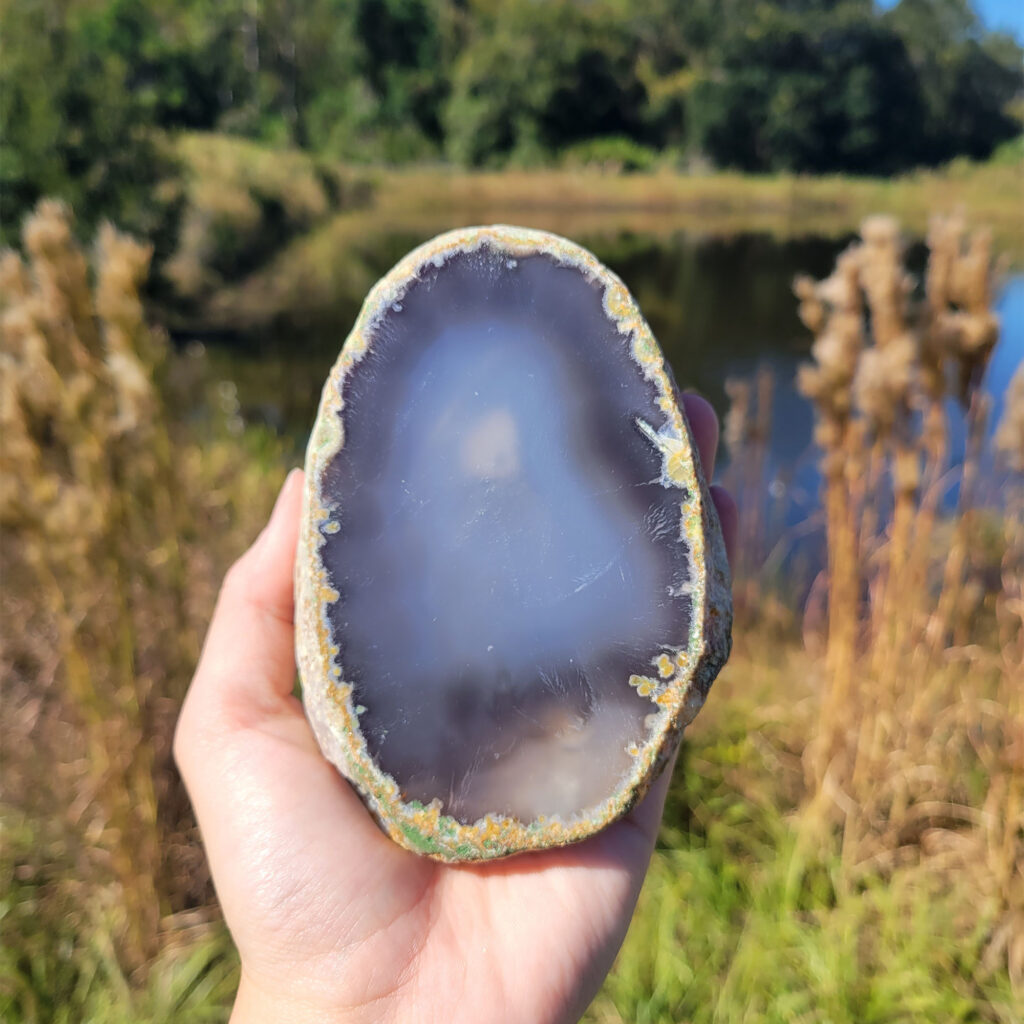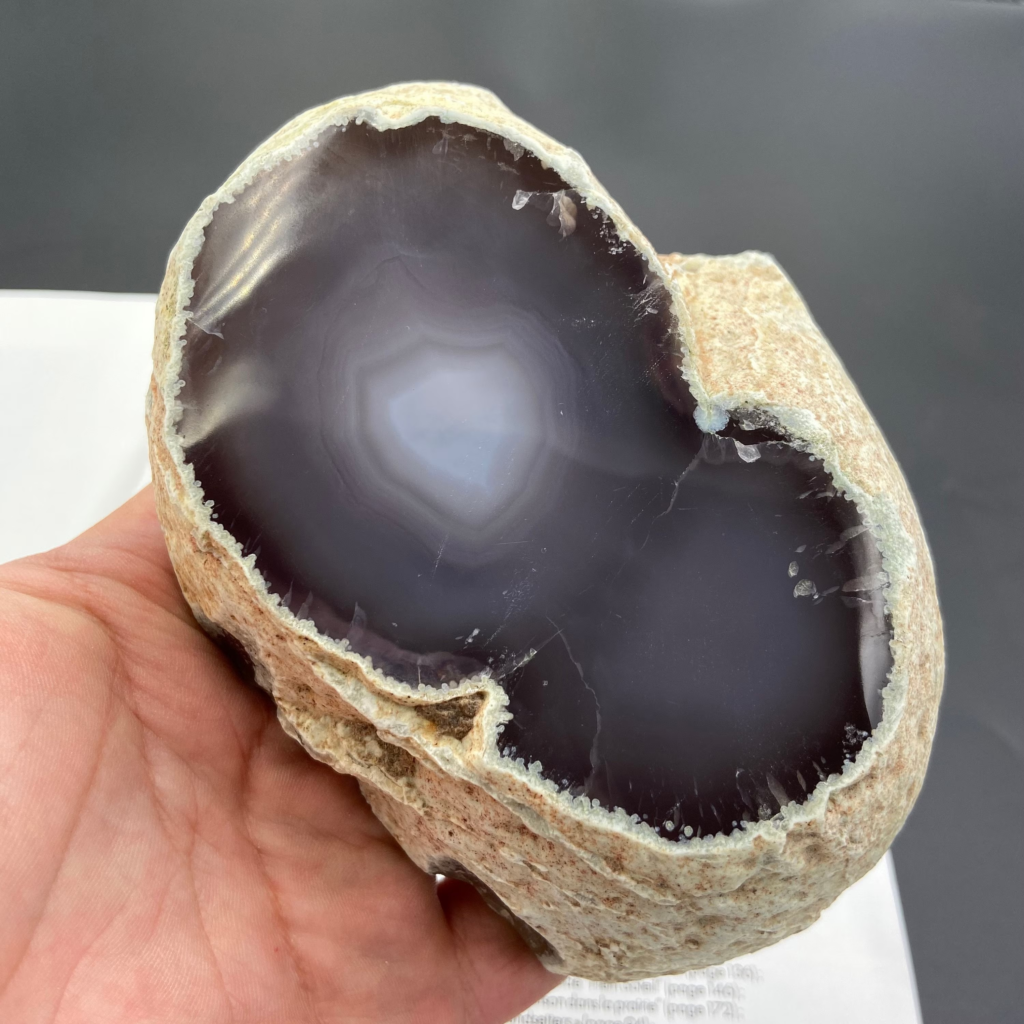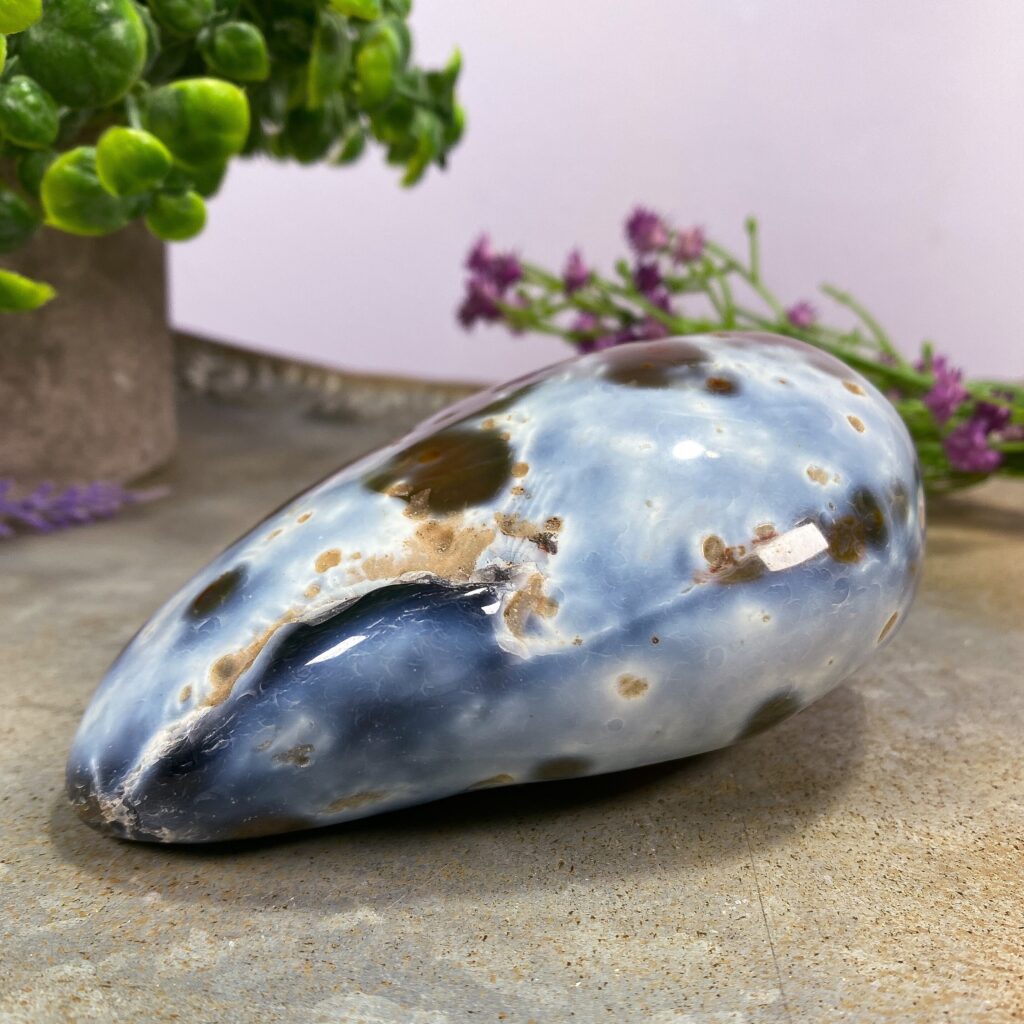Enhydro agate is a type of agate stone that contains water or other fluids trapped within its cavities or inclusions. These pockets of water are typically remnants from the stone’s formation period, encapsulating ancient fluids that can be millions of years old. The term “enhydro” comes from Greek, meaning “in water.”

Enhydro agates are fascinating geological specimens prized by both collectors and enthusiasts for their aesthetic beauty and scientific intrigue. Formed within volcanic rocks or ancient geodes, these stones develop as mineral-rich solutions seep into rock cavities and slowly crystallize over time. The water trapped inside is often visible as a small, movable bubble when the stone is rotated, making each piece unique.
The uniqueness of enhydro agate lies in its encapsulated ancient water, providing a rare glimpse into the geological history of the Earth. This characteristic not only makes them valuable to collectors but also to scientists studying the Earth’s climatic and environmental conditions of the past. Enhydro agates are also appreciated for their metaphysical properties, believed to enhance emotional balance and spiritual growth, adding to their significance and appeal.
Geological Formation of Enhydro Agate

Creation of Agate Agate forms in volcanic rocks or ancient lava flows where cavities or voids are created by gas bubbles. Over time, these cavities fill with silica-rich water. As the water evaporates, silica precipitates out, layering itself in concentric bands that harden into chalcedony, a microcrystalline form of quartz. This process can occur over millions of years, leading to the creation of agate’s distinctive banded appearance.
Enclosure of Water During Formation During the formation of agate, some cavities may remain partially filled with water or other fluids. As silica continues to deposit and seal the cavity, these fluids become trapped inside. This encapsulated water is what defines enhydro agate. The presence of fluid inclusions is a rare and unique occurrence, making enhydro agate a highly sought-after mineral.
Geological Conditions Required For agate, and consequently enhydro agate, to form, specific geological conditions are necessary:
- Volcanic Activity: The initial cavities are typically formed in volcanic rocks.
- Silica-Rich Solutions: The presence of silica-saturated water is crucial for the formation of agate.
- Slow Evaporation: The gradual evaporation of water allows silica to precipitate and form layers of chalcedony.
- Stable Geological Environment: Long periods without significant geological disturbance are needed to allow the agate to form and the water to be trapped within it.
Typical Locations and Distribution Enhydro agates are found in various parts of the world, often in regions with a history of volcanic activity. Some of the most notable locations include:
- Brazil: Known for its rich deposits of various types of agate, including enhydro agate.
- Uruguay: Another prominent source of high-quality agate with fluid inclusions.
- United States: Particularly in states like Oregon and Montana, where volcanic activity has historically created suitable conditions.
- Madagascar: Famous for its diverse and vibrant agates, including those with water inclusions.
These locations provide the unique combination of geological conditions necessary for the formation of enhydro agate, making them significant sources for collectors and researchers alike.
Physical and Chemical Properties of Enhydro Agate

Physical Properties
- Color: Enhydro agate can display a variety of colors, including shades of white, gray, blue, red, orange, and brown. The banding patterns typical of agate are often visible.
- Transparency: The degree of transparency can vary from opaque to semi-transparent, especially in areas surrounding the fluid inclusions.
- Hardness: It has a hardness of 6.5 to 7 on the Mohs scale, making it a relatively hard and durable mineral.
- Luster: The luster is typically waxy to vitreous.
- Structure: Composed of microscopic interlocking crystals of quartz, giving it a dense and durable structure. Enhydro agates often exhibit concentric banding.
- Density: The specific gravity of agate ranges from 2.58 to 2.64.
Chemical Properties
- Chemical Composition: SiO₂ (Silicon Dioxide).
- Inclusions: The water trapped inside enhydro agates can sometimes contain dissolved minerals, gases, and other impurities from the surrounding environment at the time of formation.
- Stability: Generally stable under normal conditions, but extreme temperatures can potentially cause the fluid inclusions to expand and crack the stone.
Identification and Verification
Identification Identifying enhydro agate involves examining its physical and chemical characteristics:
- Visual Inspection: Look for the banded patterns typical of agate, as well as any visible bubbles or cavities that may indicate fluid inclusions.
- Transparency Test: Holding the stone up to a light source can help reveal internal structures and the presence of fluid inclusions.
- Hardness Test: Using tools like a steel file to scratch the surface can confirm its hardness level, characteristic of quartz-based minerals.
Verification
- Magnification: Using a loupe or microscope can help identify the presence of fluid inclusions and determine if they move when the stone is rotated.
- UV Light: Some enhydro agates may fluoresce under ultraviolet light, providing another means of verification.
- Specific Gravity Test: Measuring the specific gravity can confirm it falls within the typical range for agate.
- Professional Analysis: For definitive verification, professional gemological testing can include Raman spectroscopy, which identifies the mineral composition, and fluid inclusion analysis, which can verify the presence and composition of trapped fluids.
These identification and verification methods ensure that the enhydro agate is genuine and distinguish it from other similar-looking minerals and stones.
Uses and Applications of Enhydro Agate

1. Collecting and Display Enhydro agate is highly valued by mineral collectors and enthusiasts due to its unique encapsulated water inclusions. Each specimen is considered a geological marvel, often showcased in private collections and museums. The visual appeal and rarity of enhydro agate make it a prized possession among collectors.
2. Jewelry and Decorative Items Enhydro agate is used in the creation of various types of jewelry, including pendants, rings, earrings, and bracelets. Its unique appearance, coupled with the captivating water inclusions, makes it a striking choice for jewelry. Additionally, enhydro agate is crafted into decorative items such as cabochons, beads, and polished stones, adding a touch of natural beauty to ornaments and home decor.
3. Metaphysical and Healing Practices In metaphysical and healing communities, enhydro agate is believed to possess significant spiritual properties. It is often used in meditation, energy healing, and other spiritual practices. Practitioners believe that the ancient water inside the stone can enhance emotional balance, provide clarity, and aid in spiritual growth. Enhydro agate is also thought to have grounding and protective properties, making it a popular choice for spiritual tools.
4. Scientific and Educational Purposes Enhydro agate serves as an important specimen for scientific research and educational purposes. The trapped water inclusions provide valuable insights into the Earth’s geological history, offering clues about ancient climates and environmental conditions. Scientists study these inclusions to understand more about the formation processes of minerals and the history of our planet. Educational institutions often use enhydro agate to teach students about geology, mineralogy, and Earth sciences.
5. Artistic Inspiration Artists and designers draw inspiration from the natural beauty of enhydro agate. The intricate patterns, vibrant colors, and unique inclusions of the stone inspire creative works in various art forms, including sculpture, painting, and mixed media. Enhydro agate’s aesthetic qualities make it a captivating subject for artistic expression and design.
6. Investment and Trade Due to its rarity and unique characteristics, enhydro agate can be a valuable investment. Collectors and investors often seek high-quality specimens, which can appreciate in value over time. The trade of enhydro agate also contributes to the global gemstone and mineral market, providing economic opportunities for miners, traders, and artisans.
Overall, the multifaceted uses and applications of enhydro agate highlight its significance in various fields, from collecting and jewelry making to scientific research and spiritual practices. Its unique properties and timeless beauty ensure that enhydro agate remains a treasured and versatile mineral.
References

- Mindat.org – Mindat provides detailed information on the properties and locations of various minerals, including enhydro agate.
- Mindat – Enhydro Agate
- GemSelect – This website offers insights into the physical and metaphysical properties of enhydro agate and other gemstones.
- GemSelect – Enhydro Agate
- Minerals.net – Minerals.net provides comprehensive details on the formation, properties, and uses of agate, including its enhydro varieties.
- Minerals.net – Agate
- Geology.com – This resource offers educational information on various geological formations and mineral types, including agates.
- Geology.com – Agate
- The Crystal Council – A site dedicated to the metaphysical properties of various stones, including enhydro agate, and their uses in healing practices.
- The Crystal Council – Enhydro Agate
- Gemdat.org – A database of gemstone information that includes data on the formation, physical properties, and locality of enhydro agate.
- Gemdat – Enhydro Agate
- International Gem Society (IGS) – IGS provides educational articles and resources on various gemstones, including their identification and use in jewelry.
- IGS – Agate




































